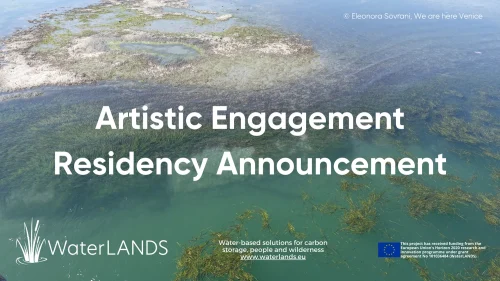Residency
2023-2026: Ems-Dollard Estuary, NL
The Horizon 2020 project WaterLANDS (Water-based Solutions for Carbon Storage, People and Wilderness) has selected seven artists (six artists or artistic collaborations) to complete a 4-year part-time placement as part of the WaterLANDS Artistic Engagement Residency.
The successful artists are Maria Nalbantova (Bulgaria), Elo Liiv (Estonia), Christine Mackey (Ireland), Claudio Beorchia (Italy), Marjolijn Dijkman (Netherlands), and Laura Harrington and Fiona MacDonald(Feral Practice) (United Kingdom).
The WaterLANDS Call for Artists invited artists to apply to work at one of the six wetland Action Sites where restoration will take place. The call received almost 500 applications of high quality and diversity. To ensure a fair selection process that was grounded in the local context, the coordinating organisation University College Dublin (UCD), and an external artistic expert worked with the local project partners at each site to conduct panel interviews and reviews to select artists or artist teams for the six sites. These artists will engage with the local community and the restoration process at the Action Sites located in Bulgaria, Estonia, Ireland, Italy, the Netherlands, and the United Kingdom.
Dr Shane McGuinness, WaterLANDS Deputy Coordinator, UCD, said “Restoration brings cultural as well as ecological renewal. Through these residencies we want art to be an integral part of creating and reflecting that renewal. We were amazed and delighted to receive so many outstanding applications from all kinds of artists with excellent ideas to work with the wetland sites, restoration teams and local communities.”
The Ems-Dollard estuary is located on the border between the Netherlands and Germany where the river Ems meets the Wadden Sea, one of the world’s largest tidal areas. The estuary is renowned for its sandflats, mudflats, and coastal salt marshes. The current shape of the Ems-Dollard estuary is strongly influenced by human actions. The size of the estuary has decreased due to the sedimentation of sand and silt, and the reclamation of salt marshes along the coast and sea level rise will threaten the survival of coastal wetlands.

